Espionage
Spying is as old as history. In the Bible, God tells Moses to "spy out the land of Canaan" and the book The Art of War, written by Chinese author Sun-tzu in 400 BC, discusses five types of spies. Today, the media presents an image of spies that is very glamorous. The smooth lines of James Bond ("The name's Bond, James Bond") and the fighting skills of Jason Bourne (from "The Bourne Supremacy") give us a very exciting, and often skewed, view of spies. These Hollywood characters inspire many people to enter the field of espionage. The U.S. CIA employs around 150,000 people and the Russian KGB employs about 1 million people. The majority of these people never become anything even somewhat resembling the romantic and cunning spies of the media. The truth behind modern espionage may not be as wild, but it is certainly fascinating.
CIA
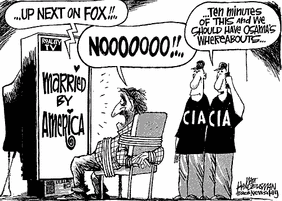
For most of the U.S.'s history, an intelligence agency has not existed during peacetime. Spies were common in war (remember Benedict Arnold?), but after the fighting stopped so did the spying. In fact, espionage was widely frowned upon by the American people. The only central intelligence agency between the two world wars was a decoding agency called the "Black Chamber". The program was shut down due to anti-espionage sentiment of the people. The government official in charge of the shut down, Henry L. Stimson, stated, "Gentlemen do not read other gentleman's mail." It was not until December 7, 1941, "a day that will live in infamy," that the need for a central intelligence agency became apparent. There had been many warning signs about the Japanese attack on Pearl Harbor, but due to the lack of centralized communication the government was not prepared. The Central Intelligence Agency (CIA) was created on March 12 1947 in the National Security Act of 1947. Because many people were afraid of the CIA turning into a secret police, similar to Russia's KGB (see below), it was not given the power to make arrests or to use any other law enforcement powers. The amount of power held by the CIA has been in question since its conception. The agency slowly gained power from it's beginning to the 1970s. During that time, CIA abuses, such as listening in to American citizen's telephone conversations, were investigated and made public. The CIA cut its employees by fifty percent. However, the 1980s brought on a strong revival in espionage due to the influx of espionage operations against the U.S. discovered in the late 1980s. A long standing argument of the CIA is that covert operations are essential to American survival against enemies who are using very invasive and secretive methods. The effectiveness of the CIA remains a mystery since only failures become public and successes are never heard of by the people. The president does have the final say over large decisions, though there have been claims that the CIA is not always truthful with the President. Every day the president receives a document marked "The President's Daily Brief" from the CIA, though its contents have never been revealed.
KGB
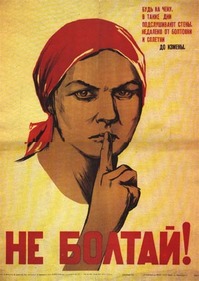
KGB Soviet poster
The KGB is the Russian secret police force known for its uses of deception, torture, and assassination to achieve its goals. KGB stands for Komitet Gosudarstvennoi Bezopastnosti, or the Committee of State of Security. The modern Russian secret police has evolved from the Cheka, created in 1917 to eliminate anti-Bolsheviks, or anti-Communists. The agency was called the GPU, OGPU, NKVD and the MGB, until finally becoming the KGB in 1954. These organizations are believed to be behind the assassinations of Stalin's enemies, including Leon Trotsky, during his time as premier of the Soviet Union. While the original agents of the KGB were thought to be little more than Russian thugs in suits, the agents of the later 20th century and 21st century are highly trained and socially skilled. Agents are given military clearance, even if they are not part of the army. It has been rumored that KGB agents are persuaded to join the agency through blackmail. Often candidates will be tricked into doing something embarrassing or illegal and then forced to join the KGB. Agents are first assigned to towns in Russia, where they are trained in espionage and counter-espionage techniques. Only after successful training are they given stations in foreign countries, sometimes retaining false identities. After the collapse of the Soviet Union in 1991, the KGB has become less prominent in media and everyday Russian life. While the agency does exist in some form, though it is no longer called KGB, it is not as secretive or as interested in the U.S. as it was during the years of the Cold War.
The Red Scare and Rosenberg Trial
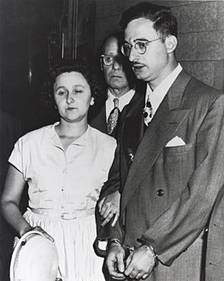
Ethel and Julius Rosenberg
Since the Soviet Union began to show interest in overthrowing the United States government to the Soviet's collapse in 1991, there has been fear of Communism in America. This fear hit its height in 1950's, the Age of McCarthyism. Senator McCarthy led the House Committee on Un-American Activities in a purge of Communists from the government. During this time period, "Communist" and "Russian spy" came to be synonymous. Hundreds of people under even the slightest suspect of being Communist sympathizers were brought to trial. The most famous case is that of Julius and Ethel Rosenberg. Ethel was the sister of David Greenglass, who confessed to giving drawings of atomic weapon's lenses to the Soviets. Greenglass implicated his brother-in-law, Julius Rosenberg, as the instigator of the spy ring. Ethel and Julius Rosenberg, David Greenglass, and Morton Sobell (another scientist who had given information to the Soviets) were tried together in March, 1951. All four were found guilty, David Greenglass was sentenced to fifteen years in prison, Morton Sobell received a thirty year sentence, and Ethel and Julius Rosenberg were sentenced to death by electric chair. The Rosenberg's sentence was appealed many times and their execution date moved back five times. Their trial was a topic of international debate, and many arguments were made for their release, including accusing the U.S. court of anti-Semitism and finding loopholes in the law. Despite these protests, the Rosenberg's were executed on June 19, 1953. They were the first American citizens to be sentenced to death for espionage during peacetime. The debate over their fate still persists today.
Capture
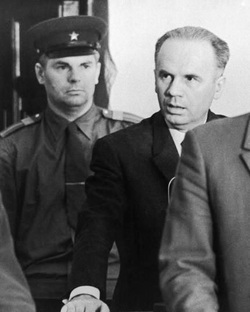
Colonel Oleg Penkovsky at trial.
Whenever espionage occurs there is always the possibility of detection. This is the risk of being a spy. There are high penalties inflicted on captured spies not lucky enough to be traded back to their country. George Blake, a British intelligence agent, was convicted of giving information to the Russians while stationed in West Berlin. He was caught, convicted, and sentenced to forty-two years in prison, one year for each of the forty-two agents his transgressions had helped kill. However, Blake escaped from prison in 1966 in a plot similar to something seen in a movie. After smuggling in a two-way radio to Blake, his accomplice informed him when the cost was clear by speaking into a radio disguised as a flower. Blake was then able to make his escape with help from the KGB.
The Russian Colonel Oleg V. Penkovsky was frightened by the idea of a Russian nuclear attack on the U.S. He offered to spy for Great Britain and America to help prevent this from happening. In a little over a year he sent the U.S. and the U.K. almost 5,000 photographs of Soviet documents. When the Russians introduced missiles into Cuba, President Kennedy needed to know if Russia was able to launch a nuclear attack on the U.S. Once Penkovsky assured the president that Russia was far behind the U.S. in the arms race, the president was able to demand that the Russians dismantle the Cuban missiles. In his haste to deliver the message however, Penkovsky was caught by the KGB and convicted as a spy for the West. He was sentenced to execution by firing squad.
In 1968 the Pueblo, an American ship, was captured off the coast of North Korea. The ship carried scientific instruments used to detect submarines. One crew member was killed during the capture, while another ten were wounded. The North Koreans accused the crew of spying and held them as prisoners for eleven months. During this time, the men were tortured into signing statements admitting their guilt and denouncing U.S. foreign policy. When the men were finally returned home, they were questioned by congress for signing the statements, a direct violation of the 1955 Uniform Code of Military Justice. This event raised the question of whether or not confessions made under torture can be considered betrayal.
In June of 2010, ten Russian spies were arrested by the U.S. government. They lived “deep cover” lives, in which they posed as Americans and kept their Russian backgrounds secret. They were so assimilated into American culture that their neighbors believed them to be American. They often had children and lived in pairs to look like normal American couples and lived all over the country. They spent almost twenty years integrating into their American lives and kept communications with the Russian government throughout that time. As you probably remember, this briefly re-sparked the American fear of Russian spies so prevalent in the mid-20th century.
The Russian Colonel Oleg V. Penkovsky was frightened by the idea of a Russian nuclear attack on the U.S. He offered to spy for Great Britain and America to help prevent this from happening. In a little over a year he sent the U.S. and the U.K. almost 5,000 photographs of Soviet documents. When the Russians introduced missiles into Cuba, President Kennedy needed to know if Russia was able to launch a nuclear attack on the U.S. Once Penkovsky assured the president that Russia was far behind the U.S. in the arms race, the president was able to demand that the Russians dismantle the Cuban missiles. In his haste to deliver the message however, Penkovsky was caught by the KGB and convicted as a spy for the West. He was sentenced to execution by firing squad.
In 1968 the Pueblo, an American ship, was captured off the coast of North Korea. The ship carried scientific instruments used to detect submarines. One crew member was killed during the capture, while another ten were wounded. The North Koreans accused the crew of spying and held them as prisoners for eleven months. During this time, the men were tortured into signing statements admitting their guilt and denouncing U.S. foreign policy. When the men were finally returned home, they were questioned by congress for signing the statements, a direct violation of the 1955 Uniform Code of Military Justice. This event raised the question of whether or not confessions made under torture can be considered betrayal.
In June of 2010, ten Russian spies were arrested by the U.S. government. They lived “deep cover” lives, in which they posed as Americans and kept their Russian backgrounds secret. They were so assimilated into American culture that their neighbors believed them to be American. They often had children and lived in pairs to look like normal American couples and lived all over the country. They spent almost twenty years integrating into their American lives and kept communications with the Russian government throughout that time. As you probably remember, this briefly re-sparked the American fear of Russian spies so prevalent in the mid-20th century.
Spy Swap
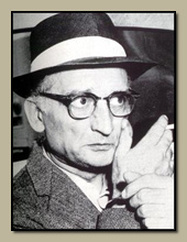
Rudolf Abel
In 1962, the U.S. traded a captured Russian spy, Rudolf Abel, for Francis Gary Powers, an American pilot accused of espionage. This was the first time a swap of spies was made between the U.S. and another country. This also effectively ended the U.S.'s policy of denial. In the past, when spies were lost to the enemy the U.S. would never admit that the person had been a spy or that the U.S. was involved in espionage at all. This was the first time that two countries admitted publicly that they employed spies and that these spies were valuable enough to free captured intelligence agencies. This swap was highly controversial. Many believed that the trade was not "equal". Rudolf Abel was one of the best Soviet spies ever, continuing to provide the Soviet Union with top secret U.S. intelligence for years. He was described by FBI agents who captured him as an "intellectual, a gentleman and ... fascinating." The FBI offered him double what the Soviets paid him to defect to the U.S. but he refused. In comparison, Francis Gary Powers was not even a spy. He was a pilot commissioned to take photos of Soviet Union rocket bases. When his plane was shot down by Soviets, he was captured. President Kennedy defended the swap, stating that it would improve U.S., Soviet relations. While the fairness of the trade is questionable, it began a practice of trading spies that is still used.
Sources
Images:
Images:
- Handelsman, Walt. "CIA Tries out New Torture Technique." Cartoon. Usr/bin/geek. 3 May 2003. Web. 10 Apr. 2011. <http://www.usrbingeek.com/a/000404.php>.KBG Photo: http://www.ets.ru/e/pk000033.htm.
- Vatolina, N. N., and N. V. Denisov. Don't Blab! Soviet KGB Poster. Photograph. Web. 10 Apr. 2011. <http://www.ets.ru/e/pk000033.htm>.
- Oleg Penkovsky. Photograph. Phoobos. Web. 10 Apr. 2011. <http://phobos.ramapo.edu/~theed/Cold_War/c_Khrushchev_era/g_Bay_of_pigs/Media/ee_BerlinWall/oleg_penkovsky.jpg>.
- The Rosenbergs. Photograph. Political Affairs. 25 Nov. 2008. Web. 10 Apr. 2011. <http://www.politicalaffairs.net/the-rosenberg-case-in-historical-perspective-40312/>.
- #4 Rudolf Abel. Photograph. Spy Missions. The Spy Museum. Web. 10 Apr. 2011. <http://www.spymuseum.com/pages/missions.html#>.
- Fraser, Erica. "Post-Cold War Espionage Between the United States and Russia: How Has the Mission Changed?" History Behind the Headlines: The Origins of Conflicts Worldwide. Ed. Sonia G. Benson, Nancy Matuszak, and Meghan Appel O'Meara. Vol. 4. Detroit: Gale, 2002. Gale Student Resources In Context. Web. 10 Apr. 2011.
- Rogers, Simon. "Russian Spy Ring: Details of the Allegations, as a Spreadsheet | News | Guardian.co.uk." Latest News, Comment and Reviews from the Guardian | Guardian.co.uk. 29 June 2010. Web. 10 Apr. 2011. <http://www.guardian.co.uk/news/datablog/2010/jun/29/russian-spy-ring-allegation-details>.
- Silverstein, Herma. Spies Among Us: The Truth Behind Modern Espionage. New York [etc.: Franklin Watts, 1988. Print.
